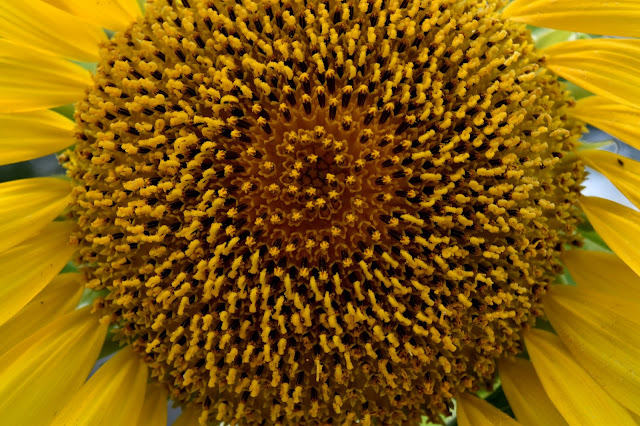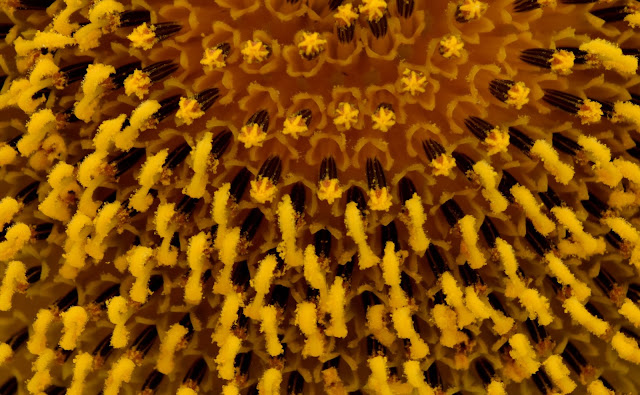The bees and wasps were happy too! I saw several kinds visiting during the day!
Sunflowers are composite flowers, they seem like one flower but are actually an inflorescence or a collection of flowers together. Ray flowers on the outside do the job of attracting agents for pollination of the disc flowers on the inside, which are small and in due course, form seeds.
In the first week of June, this one unfurled its ray flowers and smiled! It was big! Three others that followed suit were equally large or larger. The disc flowers in the center were arranged in a beautiful pattern!
With a diameter of about 10-11 inches, these flower heads were heavy and their 8-10 feet long stems were slightly bent carrying the load. They still held them up high against the blue summer skies, and it made a striking contrast.
The disc flowers on the periphery open first. Progressively, they continue to open in concentric rings towards the center as the flower head grows in size and the ones outside are pollinated. The yellow ray flowers attract agents for pollination.
I had three large ones by mid June. You can see how the disc flowers that have bloomed form a wider ring around the center now.
Almost all the central flowers are open now, and closeup views of the center are simply beautiful!
Please click on each picture for details.
The inside whorl of disc flowers are now ready for pollination as the outside whorls are forming seeds.
Does this not remind you of an intricately decorated cake!
The black portion of the disc flowers (note the striped pattern on them) will eventually become the seed.
The outside whorls of flowers now have a star like appearance and the beautiful saga continues!
Finally, the ray flowers have finished their job of attracting pollinators to the flower head and start drying up. The seeds in the center start developing.
One morning, as I stepped out into the yard to see how the sunflowers were doing, I noticed one head completely hollowed out! All the seeds were gone!
Looking down, I noticed the hulls of seeds scattered on the ground! It was the work of a squirrel, as I noticed afterwards when it returned to make sure it had gotten everything. The flower head was very close to a cross bar of the fence, and it was a perfect place to sit on while feasting!
I got the two other flower heads off the stems and put them out to dry.
You can see the same pattern of the disc flowers that were now seeds. Some disc flowers can still be seen in the center.
After scraping off all the disc flowers, it looks like this!
Close up of the seeds.
I pulled out a few seeds at first to check if they were dry. Note the stripes on the seeds that were also seen in the closeup of the center.
These striped seeds are known as confection seeds. They make a delicious and nutritious snack and are used in salads, trail mixes, and other food. These are not oil producing seeds.
The lighter ones were ready too.
That's a nice number of seeds after they were all pulled out.
The empty centers reminded me of bee hives. They went into the composter.
The seeds! The hull is on the left, and once you pry it open (dehull), the edible seed (kernel or heart) is seen on the right.
I got a decent sized crop of seeds from this batch.
Next year, I will make sure I plant seeds in succession, three batches 15 days apart, so I keep getting flower heads throughout summer.

























Good to learn new things. For some years, I have been using sunflower oil for all dishes requiring oil for frying or Phodani.
ReplyDeleteThank you!
DeleteWow!! That's real neat!!!!
ReplyDeletePictoral feast for the eyes, supported with awesome information!
Kudos..more force to you 👍
Thanks a lot, Madhumita!
DeleteVeena the article is excellent. I had never seen a Sunflower so closely. Its amezing. I learnt so many new things because of this article. The photos are too good but then I
ReplyDeleteneed not comment on them like I don't have to comment on the language !!
Thanks a lot, Nandini! I have enjoyed all my sunflowers and their pictures this summer.
DeleteVeena, I truly didn't know that you wrote a blog. I came across it through one of my 'visits' to Facebook. And must say, I am addicted. The writing is crisp and the pictures are BEAutiful!! Inspired!! Keep posting.
ReplyDeleteThank you Chetan! I truly appreciate your feedback with your lovely comments.
DeleteWow!! This is a lovely lovely post!! Amazing pictures!! And what a loot you now have of the seeds!! Enjoy!!
ReplyDeleteThanks a lot Sumi. Yes, the seeds are quite a nice snack once roasted.
DeleteAmazing Pictures Veena.....
ReplyDeleteThank you!
DeleteThis comment has been removed by the author.
ReplyDeleteLovely pictures and great explanation. Didn't know ow lots of the facts you shared. Thank you for sharing
ReplyDeleteThank you for reading and leaving a comment.
Delete